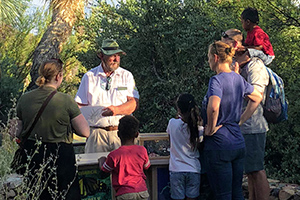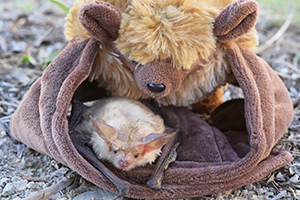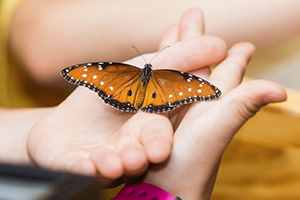Aquatic Insects of the Sonoran Desert
The biological diversity and abundance in natural waters of the desert can be almost overwhelming, especially when we look beyond the fish and other aquatic vertebrates to the more diverse group�invertebrates. Dozens of species often share a single site in a desert stream. The types and morphological traits of aquatic insects present are closely related to the type of stream habitat, as well as to the kinds of food energy that are available.
The abundant light in most desert streams supports the growth of algae and other plants on stream bottoms, which feed what stream ecologists call grazer-scrapers. Riparian plants drop leaves and other debris which, along with associated bacteria and fungi that decompose the material, sustain what are called shredders. Another form of food is fine organic particles, some that has passed through guts of other animals, that collectors ingest. Finally, predators, at a higher trophic (feeding) level, eat all the other groups of insects, including other predators!
Feeding habits only partially explain the diversity of aquatic insects in desert streams. Different lifestages�larvae, pupae and adults of various species�are found throughout the riparian ecosystem, even far below the stream substrate. In many cases aquatic insects are the larval or nymphal stages of winged adults that will leave the stream to reproduce and disperse in the terrestrial environment.
Conditions vary from the water surface to the streambed, and from midstream to water�s edge; each area has its own set of invertebrates. Their shapes, sizes, and behaviors, however, are varied, and depend upon the micro-habitat that each occupies. Each must obtain enough oxygen, which is present at lower concentrations in water than in air, especially in slow water, so most aquatic insects living below the surface have gills of some sort, but these are diverse as well. Furthermore, different flow regimes have profound effects on the populations. Riffles have rapid flow and turbulence roiling the surface, as water goes over shallow rocks. Pools are deeper, with slow-moving water and often bottoms of sand or silt; detritus collects in slower spots. Runs are deeper zones of moderate current, with combinations of sandy and rocky substrates.
Stream Riffles
In riffles, obviously, insects must be able to hold on. Mayfly nymphs of the genus Baetis (family Baetidae) are a little less than K-inch (1 cm) long and streamlined for lessened resistance to the force of moving water, as they cling to rocks, plants, or other substrates with sharp tarsal claws. You may see nymphs of this ubiquitous mayfly swimming freely if you place a clump of the filamentous green alga Cladaphora (often abundant in desert stream riffles) in a pan of water. Baetis has a row of small gills lining the abdomen: these are sufficient in the well-oxygenated fast-flowing water and also present little surface area for drag. Baetis feeds on diatoms and fine organic material.
Other mayfly nymphs, such as algae-grazing Heptageniidae, are flattened; they are protected from high flows within the thin boundary layer where friction results in a zone of relatively low flow immediately adjacent to rock surfaces. Even some beetles are flattened, such as the disc-like larval �water penny�(family Psephenidae). Such flattening may also allow the water penny larvae to squeeze between crevices to feed on detritus on the underside of boulders, where they are common.
Some insects take advantage of the flowing water. The larvae of the Hydropsychidae caddisflies use silk from modified salivary glands to construct tent-like nets in fast water. The net is open upstream to capture food particles such as pieces of leaves or drifting organisms, while the insect stays hidden within its retreat. Nearly any rock that you pick up in a fast riffle will hold many of these nets, and the intricate mesh appears surprisingly delicate for such a high-stress environment.
One of the only truly aquatic lepidopterans is a moth in the family Pyralidae, which also makes a tent in somewhat slower water�a grayish-white sheet ¼ to 1 inches (1-2 cm) in diameter over a rock crevice. The larva undulates slightly to circulate water through the small holes at the tent edges and past the dense gill tufts lining its abdomen.
In the very fastest water, the blackfly larva (Simuliidae) attaches itself to a rock or branch with a circular row of hooks at the end of its abdomen. From this anchor, it gathers food by extending a pair of retractable fans from its head that trap drifting organic particles. The aggressive blackfly larvae nip at neighboring insects that disrupt this food conveyor belt, thereby maintaining a small competitor-free territory that looks like a halo around the insect. Blackflies achieve impressive densities; often over 100 larvae in an area the size of your hand.
Another abundant dipteran, the midge Rheotanytarsus (Chironomidae), cements a J-inch (4 mm) long tube to rock, and attaches silk to prongs projecting from the outer end of the tube that acts like a net, filtering particles from the fast-water current. This pronged tube looks like a dried-out hydra. The gills for both these dipterans are small, simple tube-like structures at the ends of their abdomens�adequate in these well-oxygenated sites.
Although most beetles are found in slower water, two groups inhabit riffle areas. The riffle beetle (Elmidae) is less than J-inch (3 mm) long, both as a slender, tapered larva and as a chunky, longish-legged adult. Both stages clamber slowly over the substrate and feed on detritus. The adult riffle beetle has a dark oval body, usually with 4 orange or yellow spots on its wing covers, and appears hunch-backed with its head somewhat tucked into its thorax. The second beetle found in riffles, the long-toed water beetle (Dryopidae), is the only known case in which an aquatic adult insect has a terrestrial larval form; it burrows in moist sand above the stream. The K-inch (1 cm) long, black adult with grooves on its upper surface spends its life slowly scavenging detritus and algae.
The largest riffle dwellers are the Corydalidae, or dobsonflies of fishing fame, which reach up to 2 inches (5 cm) long. These larvae live under stones in fast, rocky areas. Corydalids are obvious predators with huge jaws that are as big as their heads. Their bodies are soft, however, with long tube-like gills extending straight out from the sides of each abdominal segment and a pair of hooks at the tail end for holding on in the current.
Stream Pools
Insects living in pools or slow-moving water tend to be bulkier. The slow-water mayflies like Callibaetis or Centroptilum (both Baetidae), somewhat broader than their riffle-inhabiting cousins, perch well above the bottom rather than hunkering down. They flap their larger gills to create water movement. Two other common mayflies here, Caenidae and Tricorythidae, have very compact body shapes that allow them to forage for detrital food in silty areas. Fine sediments can harm sensitive respiratory surfaces, so the first pair of gills has been enlarged into a tough plate that covers the other gills. Gills on the Leptophlebiidae, on the other hand, are long and large, with double surfaces that look somewhat like a row of tuning forks extending from the abdomen.
In slow water a Polycentropodidae caddis larva makes a flimsy, tube-like net usually about ¾- to 1¼-inch (2 to 4 cm) long on rock surfaces; it reaches outside this net to collect fine particles or to snatch prey. An intriguing caddis (Helicopsychidae), occasionally abundant grazing in gravelly areas, has a spiral case resembling a snail shell about 3/16-inch (5 mm) tall, made of sand and glue from its salivary glands.
Pools provide habitat to a great many aquatic beetles. Both larval and adult stages are aquatic in the families Dytiscidae (predaceous diving beetles) and Hydrophilidae (scavenger beetles). Dytiscid adults swim to the pool�s surface with the abdomen tip pointed upward, and gather air in a bubble under the elytra or wing-covers; hydrophilids, which clamber over pool bottoms and vegetation, also gather air, but come to the surface head first. Both use the thin bubble or plastron, which is held in place by extremely dense hairs or �hydrofuge,� as a virtual gill, through which oxygen diffuses from the water and is taken up through the spiracles. The larvae, however, are generally wormlike, adapted for burrowing through bottom materials in search of prey. Once prey (even the occasional tadpole or small fish) is captured, the dytiscid larva inserts its sickle- like mandibles into it, injects digestive enzymes through grooves on the inner surface of its mandible, and then sucks up the partially digested contents.
Slower water is almost a predator soup; currents carry drifting organisms from fast water into slower areas, where they are vulnerable to a remarkable abundance of predators. Some interesting predators are in the order Hemiptera (true bugs). Almost all of these have sucking mouthparts and most of them occur in streams as both nymphs and adults. The water scorpion (Nepidae) perches like a praying mantis in aquatic plants or other debris, waiting for invertebrates to come near. It extends a �siphon� from the tip of its abdomen to breathe air from the surface. Toe-biters (Belostomatidae) sit among stream-edge plants, but these insects that reach up to 2 inches (5 cm) in length also crawl or swim slowly along the bottom, often preying on snails. You may see a toe-biter with its back covered with rows of pearl-like eggs. This is always a male, carrying eggs the female laid there, presumably to keep them aerated and to protect them from predators; these are among the largest eggs of all the insects. This is one of the few cases of male parental care in invertebrates!
Backswimmers (Notonectidae) and water boatmen (Corixidae) are more typically mid-water predators that capture aquatic insects swimming or drifting in the pools, and also take terrestrial insects that fall to the surface. One corixid, Hesperocorixa, is unique among the aquatic Hemiptera because it is an herbivore rather than a predator, grinding up (rather than sucking) parts of aquatic plants.
No predator soup would be complete without dragonflies and damselflies, the entire Order Odonata being predaceous, both as adults and nymphs. Damselfly nymphs have 3 leaf-like gills protruding from the ends of their abdomens, while dragonfly nymphs have spiny posteriors that suck oxygenated water into their rectums where the oxygen is absorbed. Many nymphs dart through the water by rapidly forcing the water out of their rectums�jet propulsion! The Libellulidae are usually brightly-patterned nymphs that crawl across the bottom searching for prey, while the Gomphidae sit and wait for their victims to stumble by. One gomphid is a flattened insect (with wide, flat antennae as well) that sits on the bottom, while another gomphid hides just under the sand, waiting for vibrations to indicate prey coming by. Quiver your hand over clean, shallow sand and watch for movement of this hidden insect. Another dragonfly (Cordulegasteridae), more common in pools in small, rocky streams, is hairy and usually covered with foreign material, camouflaged and motionless, waiting for prey.
Most damselfly nymphs are slender. The Calopterygidae perch on plants or tops of rocks on long legs; they snatch insects and small crustaceans in quiet pools. Another damselfly in the family Coenagrionidae, the only odonate common in flowing water, crawls through leaves and roots of slow runs. Its more compact shape protects it from vagaries of the current.
The face of a damselfly or dragonfly nymph appears to be covered by a toothed mask. This is actually a retractable set of mouthparts that can extend instantly up to 2 to 3 head-lengths in front of the insect, then open sideways to grab a victim. You can readily pull this contraption outward to see how it functions; dragonfly nymphs are particularly sturdy.
Odonata adults cruise the streamside in search of flying insects, which they capture �on the wing� with legs that are covered with long hairs forming basket traps. Dragonflies extend broad wings outward, while damselflies� slender wings are held back over the body. Skimmers (family Libellulidae) sit on the tips of plants, darting out to catch flying insects. They also patrol stream margins to defend their feeding and reproductive territories against other dragonflies.
Odonate mating and oviposition behaviors are also complex. A male may appear to be looped awkwardly behind a female, using the claspers at his tail end to hold her �neck,� while contacting the genital openings to pass sperm. Damselflies like Argia often fly in tandem, the blue male attached to the tan female with his claspers. To defend his genetic contribution from competing males, he stays attached while she oviposits eggs into algal mats and other soft streamside materials. There are even reports that males of some species have hooks for pulling out sperm deposited earlier in the female by another male! Many female dragonflies and some damselflies release their eggs on the wing, touching their abdomens to the water during the release, or dropping the eggs from the air like dive-bombers. The eggs drift downward, becoming sticky enough when wetted to adhere to the bottom.
Surface Film
Neuston is the collective term for organisms, such as the water striders (Gerridae, Veliidae), that live on the water surface; technically many of these airbreathers are not true aquatic insects. Most neustron prey on terrestrial insects that fall into the water.
Water striders� terminal leg segments covered with unwettable hairs allow the insects to �skate�on the surface supported by surface tension. Retractable tarsal claws, used as paddles, penetrate the surface film, giving traction without breaking through. The body weight deforms the surface film, often creating six spots of refracted light on the stream bottom below. Adding detergent to the water would break the surface tension, and the strider would fall in and drown. Smaller veliids jet forward by releasing saliva that breaks the surface film; the physical-chemical reaction pushes them forward.
Beetles of the whirly-gig family (Gyrinidae) have a split view of the neustonic feeding area: the upper portion of their eyes seeks prey floating on the surface, while the lower pair searches for prey (and scans for predators) below. Often gyrinids spin madly at the surface in groups of 30 or more.
You may see Chironomidae midges and mayflies swim up to the surface and burst out of their pupal (midges) or larval skins, rest for a moment, and then fly off to continue their life cycles This is the hatch that flyfishermen try to mimic.
Stream Margins� The Littoral Zone
The stream edge is another transition area. On the aquatic side, the creeping water bugs (Naucoridae) are highly flattened, almost disk-shaped. They crawl on sand and gravel in shallow water and have muscular front legs that make them look like weight lifters. These legs are used to hold prey while the bug sinks its beak into the hapless victim; caution�painful to you as well! The related, less painful, but drier, toad bug (Gelastocoridae) is a curious stream margin hemipteran, highly mottled and squat, with �bug-eyes�; it pounces upon insects in wet sandy-gravel sites.
Many beetles of the families Carabidae (ground beetles) and Staphylinidae (darkling beetles) are often abundant at water edges or areas drying as waters recede, where they scavenge other invertebrates left high and dry. Tiger beetles (Cicindellidae), also very common on sandy stream shores, are highly active and aggressive predators on insects near the water, or crawling/emerging onto land from the water. More often on the wing than typical beetles, tiger beetles display impressive sickle-like mandibles and beautiful metallic colors.
This is also the zone where many insects leave the water and hatch as adults. During warm months caddisflies, having gone through their pupal stages under rocks, come to the edge to break open their skins, crawl out, and dry off their wings. Fascinating enough to watch as this is, it is even more amazing to see orange-colored mites come from seemingly nowhere to climb onto an emerging caddisfly and hitch a ride�their means of dispersal. Often one sees the hollow husks (exuviae) of already-flown caddisflies, dragonflies, and damselflies still clinging near the water�s edge.
Sub-Surface Creatures
Probably the most bizarre of stream habitats is the hyporheic zone, which literally means �below the flow.� A variety of small insects and crustaceans dwell as many as 16 feet (5 m) under the stream bottom. Some, like the winter stoneflies (Capniidae) and a specialized chironomid midge, only come to the surface to emerge and reproduce as adults, while the crustaceans may complete their entire life cycle underground. These invertebrates survive on the bacteria and fungi which live deep within the porous sand/gravel substrate where nutrients seep into the groundwater, thus constituting a permanent community even when the surface dries totally during the dry season.
Other insects burrow just a few inches under the streambed. Crane fly larvae (Tipulidae), also called �leatherjackets� for their tough larval skin, use peristaltic motion (muscular wave-like contractions) to move through sand in search of food; out of water the worm-like larvae usually have swollen posterior ends. One common leatherjacket is a predator that is covered with short, golden hairs and feeds on smaller prey within the sand habitat, while another is a much �flabbier� detritivore, which feeds on decomposing organic material. Crane fly larvae pupate at stream edges to emerge as the familiar, long-legged �mosquito-hawks�(non-feeding) seen in shady corners or in your doorway.
Life Cycles
Insects that occupy the stream during their larval stage and then leave to reproduce as terrestrial adults, including mayflies, stoneflies, caddisflies, moths, dragonflies and damselflies, and the Diptera or true flies, spend almost their entire lives in the juvenile aquatic stage. Some mayflies, stoneflies, dobsonflies, and dipterans (for example, Chironomidae midges, Tipulidae craneflies) even have degenerated mouthparts as adults, since little or no feeding occurs in that short-lived stage. The mayfly order Ephemeroptera, in fact, has an extremely ephemeral adult stage, which lasts only 1 to a few days; some species of Baetidae mayflies don�t even require a mate, but instead produce viable eggs via parthenogenesis.
Aquatic insects have 1 of 2 basic life cycles. Direct development (egg-nymph-adult), the more evolutionarily primitive cycle, is that of the mayflies, dragonflies and damselflies, stoneflies and the Hemiptera. These insects go through variable numbers of juvenile molts or instars, gradually developing mature body parts until they finally emerge as winged adults. Mayflies, some of which have as many as 30 instars, are the only insects (aquatic or terrestrial) that molt as adults, and the winged pre-adult stage or �dun�as it is called by fishermen, has smoky-colored wings. Resting on plants or other promontories near the stream, the insects soon shed this last skin to become the familiar glassine-winged �spinners.�The Odonata typically crawl partly out of the water onto rocks (dragonflies) or sticks (damselflies), where they swell their bodies with water to burst the last nymphal skin before emerging as adults. The spent skins can be seen streamside from spring through fall. The eggs of baetids are often observed on the undersides of stones, where females have crawled back below the waterline to deposit them in lines that look like micro-honeycombs.
The remaining aquatic insects (caddisflies, moths, Diptera, and most beetles) have what�s called �complete� development (egg-larva-pupa-adult), life cycles that include a pupal stage. Usually their cycles involve a longer aquatic larval stage and a more ephem-eral terrestrial adult stage (with some exceptions as noted earlier, especially in the beetles). Pupal development lasts from less than 2 days up to 2 weeks in the larger taxa, often within a protective cocoon or chamber glued to the under-surfaces of rocks. Caddis pupae have huge sickle-shaped mandibles solely for the purpose of slicing their way out prior to emergence.
Size and Longevity
Unlike environments where colder winters restrict insect life cycles, the warm year-round temperatures in the Sonoran Desert allow many insect species to grow and reproduce throughout the year. Furthermore, warmer temperatures result in higher growth rates, so many insects can produce several generations in a year. Some caddisflies and true bugs, like the backswimmers and toe-biters can develop from egg to adult in less than 2 months and have 5 to 10 generations per year. The common mayflies, like Baetidae and Tricorythidae, and many chironomid midges, can develop in less than 2 weeks, and may have 35 generations in a year! Such development times are almost unheard of in other ecosystems, and such high production, with adult insects emerging in great abundance, partly explains why desert riparian areas are so attractive to birds and other terrestrial insectivores.
While there are many large aquatic insects in the desert, most are less than a centimeter in size, somewhat smaller than those found in streams elsewhere. This may be related to the ephemeral nature of benign conditions in the desert, because smaller animals can mature earlier, and are more likely than larger species to attain reproductive size before the next flood or drought destroys them. For example, the big blue darners (Aeshnidae), common in most of North America, are rare in the desert, probably because their 2 to 3 year life cycle makes them unsuited for an environment in which severe floods and drought occur on a frequent basis.
Survival and Repopulation
Because flash floods and summer drought can have catastrophic effects, invertebrates must have dependable means of surviving these events and re-populating the stream. Life cycles are less synchronized in desert streams than elsewhere, so at any one time there are flying adults�an �air force�ready to repopulate the aquatic environment. Summer drought may dry most of the stream, but pockets of aquatic habitat remaining in canyons or springs support residual populations that emerge and re-colonize once stream waters return. Some winged aquatic adults, like beetles and true bugs, leave streams when high flows come or survive in vegetation or other protected sites. The toe-biter is one of the only insects here to produce eggs more than once; if one batch fails due to flooding or desiccation, she returns to the water to lay another batch when conditions permit. Nearly all the insects in desert streams produce large numbers of eggs. There is very little time when this extremely dynamic ecosystem is devoid of critters!
|
|
|
| Orders: | Families: |
| Odonata | Calopterygidae, Coenagrionidae, Libellulidae, Gomphidae, Cordulagasteridae |
| Ephemeroptera | Baetidae, Caenidae, Leptophlebiidae, Siphlonuridae, Tricorythidae |
| Plecoptera | Capniidae |
| Megaloptera | Corydalidae |
| Hemiptera | Belostomatidae, Corixidae, Gelastocoridae, Gerridae, Naucoridae, Nepidae, Notonectidae, Veliidae |
| Trichoptera | Glossosomatidae, Helicopsychidae, Hydropsychidae, Polycentropodidae |
| Lepidoptera | Pyralidae |
| Coleoptera | Dryopidae, Dytiscidae, Elmidae, Gyrinidae, Haliplidae, Hydrophilidae, Psephenidae |
| Diptera | Chironomidae, Simuliidae, Stratiomyiidae, Tabanidae, Tipulidae |
|
|
|










